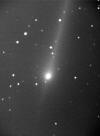C/2002 T7 LINEAR page

C/2002 T7 LINEAR, CCD image on Jun 27.39UT 2004.
10x10 second exposures. FOV 13'x19'.
Note the sunward dust tail or "antitail" pointing towards the bottom of the
frame. This is merely a perspective effect as the Earth crossed through
the orbital plane of the comet at this time and we observe the comet edge-on.
The main tail is also enhanced.

C/2002 T7 LINEAR colour CCD image on May 14th 2004 at 20:00 UT.
10x20second exposures through a Takahashi 300mm telephoto.


C/2002 T7 LINEAR, May 7th 2004 at 20:00UT.
Left: 2x2.5 degree wide FOV
Right: 20x15 second exposures through C11 at f/3.3.
Moonlight plus dew interference.

C/2002 T7 LINEAR, April 26th 2004 at 20:05UT
20x20second exposures, flat fielded. Poor conditions.
C/2002 T7 LINEAR was discovered on October 14th 2002 by the
Lincoln laboratory Near Earth Asteroid Research project at a distance of 6.9 astronomical units from the Sun.
Northern hemisphere observers were favored prior to perihelion.
It was lost into evening twilight by the start of March 2004 as a 6th magnitude
object in Pegasus.
By mid April 2004, LINEAR was recovered low in the morning sky from
both hemispheres shining at 4th magnitude.
Closest approach to the Sun occured on April 23rd 2004 at 0.61 AU (92 million kms)
in Pisces.
The comet was lost to the Northern Hemisphere by the start of May 2004. By
this time, it was well placed for Southern Hemisphere observers at 20 degrees
altitude at the start of twilight. Moonlight interfered from May 4th.
LINEAR approached solar conjunction on May 18th at which time it rapidly reappeared
in the evening sky joining C/2001 Q4 NEAT for the double comet show.
Closest approach to the Earth occured on May 19th 2004 at 0.27 AU (40 million kms). At this time, the comet
achieved peak brightness of
magnitude 2.5 and appeared prominent to the unaided eye in the constellation of Eridanus.
Moonlight interfered from May 23rd 2004.
This appears to be LINEAR's first and only passage through the inner solar
system.




